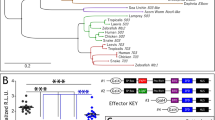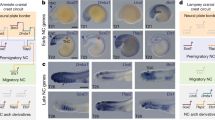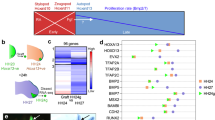Abstract
The signals that determine body part identity in vertebrate embryos are largely unknown, with some exceptions such as those for teeth and digits1,2. The vertebrate face is derived from small buds of tissue, facial prominences, that surround the embryonic oral cavity3. In chicken embryos, the skeleton of the upper beak is derived from the frontonasal mass and maxillary prominences4. Here we show that bone morphogenetic proteins (Bmps) and the vitamin A derivative, retinoic acid (RA), are used to specify the identity of the frontonasal mass and maxillary prominences. Implanting two beads adjacent to the stage-15 presumptive maxillary field, one soaked in the Bmp antagonist Noggin5 and one soaked in RA, induces a duplicate set of frontonasal mass skeletal elements in place of maxillary bones. We also show that the duplicated beak is due to transformation of the maxillary prominence into a second frontonasal mass and not due to ectopic migration of cells or splitting of the normal frontonasal mass. Thus the levels of Bmp and RA determine whether specific regions of the face form maxillary or frontonasal mass derivatives.
This is a preview of subscription content, access via your institution
Access options
Subscribe to this journal
Receive 51 print issues and online access
$199.00 per year
only $3.90 per issue
Buy this article
- Purchase on Springer Link
- Instant access to full article PDF
Prices may be subject to local taxes which are calculated during checkout




Similar content being viewed by others
References
Tucker, A. S., Matthews, K. L. & Sharpe, P. T. Transformation of tooth type induced by inhibition of BMP signaling. Science 282, 1136–1138 (1998).
Drossopoulou, G. et al. A model for anterioposterior patterning of the vertebrate limb based on sequential long- and short-range Shh signalling and Bmp signalling. Development 127, 1337–1348 (2000).
Haeckel, E. H. P. A. The Evolution of Man. A Popular Exposition of the Principal Points of Human Ontogeny and Phylogeny (Appleton, New York, 1886).
Le Lièvre, C. S. Participation of neural crest-derived cells in the genesis of the skull in birds. J. Embryol. Exp. Morph. 47, 17–37 (1978).
Zimmerman, L. B., De Jesus-Escobar, J. M. & Harland, R. M. The Spemann organizer signal noggin binds and inactivates bone morphogenetic protein 4. Cell 86, 599–606 (1996).
Noden, D. M. The role of the neural crest in patterning of avian cranial skeletal, connective, and muscle tissues. Dev. Biol. 96, 144–165 (1983).
Couly, G., Grapin-Botton, A., Coltey, P., Ruhin, B. & Le Douarin, N. M. Determination of the identity of the derivatives of the cephalic neural crest: incompatibility between Hox gene expression and lower jaw development. Development 125, 3445–3459 (1998).
Lumsden, A., Sprawson, N. & Graham, A. Segmental origin and migration of neural crest cells in the hindbrain region of the chick embryo. Development 113, 1281–1291 (1991).
Mina, M. & Kollar, E. J. The induction of odontogenesis in non-dental mesenchyme combined with early murine mandibular arch epithelium. Arch. Oral Biol. 32, 123–127 (1987).
Hamburger, V. & Hamilton, H. A series of normal stages in the development of the chick embryo. J. Morphol. 88, 49–92 (1951).
Richman, J. M. & Tickle, C. Epithelia are interchangeable between facial primordia of chick embryos and morphogenesis is controlled by the mesenchyme. Dev. Biol. 136, 201–210 (1989).
Rodriguez-Esteban, C. et al. The T-box genes Tbx4 and Tbx5 regulate limb outgrowth and identity. Nature 398, 814–818 (1999).
Takeuchi, J. K. et al. Tbx5 and Tbx4 genes determine the wing/leg identity of limb buds. Nature 398, 810–814 (1999).
Francis-West, P. H., Tatla, T. & Brickell, P. Expression patterns of the bone morphogenetic protein genes Bmp-4 and Bmp-2 in the developing chick face suggest a role in the outgrowth of the primordia. Dev. Dyn. 201, 168–178 (1994).
Wall, N. A. & Hogan, B. L. Expression of bone morphogenetic protein-4 (BMP-4), bone morphogenetic protein-7 (BMP-7), fibroblast growth factor-8 (FGF-8) and sonic hedgehog (SHH) during branchial arch development in the chick. Mech. Dev. 53, 383–392 (1995).
Niederreither, K., Subbarayan, V., Dolle, P. & Chambon, P. Embryonic retinoic acid synthesis is essential for early mouse post-implantation development. Nature Genet. 21, 444–448 (1999).
Schneider, R. A., Hu, D., Rubenstein, J. L., Maden, M. & Helms, J. A. Local retinoid signaling coordinates forebrain and facial morphogenesis by maintaining FGF8 and SHH. Development 128, 2755–2767 (2001).
Barlow, A. J., Bogardi, J. P., Ladher, R. & Francis-West, P. H. Expression of chick Barx-1 and its differential regulation by FGF-8 and BMP signaling in the maxillary Primordia. Dev. Dyn. 214, 291–302 (1999).
Shigetani, Y., Nobusada, Y. & Kuratani, S. Ectodermally derived FGF8 defines the maxillomandibular region in the early chick embryo: epithelial-mesenchymal interactions in the specification of the craniofacial ectomesenchyme. Dev. Biol. 228, 73–85 (2000).
Brown, J. M. et al. Experimental analysis of the control of expression of the homeobox-gene Msx-1 in the developing limb and face. Development 119, 41–48 (1993).
Hu, D. & Helms, J. A. The role of sonic hedgehog in normal and abnormal craniofacial morphogenesis. Development 126, 4873–4884 (1999).
Eichele, G., Tickle, C. & Alberts, B. M. Microcontrolled release of biologically active compounds in chick embryos: Beads of 200-µm diameter for the local release of retinoids. Anal. Biochem. 142, 542–555 (1984).
Fallon, J. F. et al. FGF-2: Apical ectodermal ridge growth signal for chick limb development. Science 264, 104–107 (1994).
Barlow, A. J. & Francis-West, P. H. Ectopic application of recombinant BMP-2 and BMP-4 can change patterning and developing chick facial primordia. Development 124, 391–398 (1997).
Shen, H. et al. Chicken transcription factor AP-2: Cloning, expression and its role in outgrowth of facial prominences and limb buds. Dev. Biol. 188, 248–266 (1997).
Richman, J. M. & Tickle, C. Epithelial-mesenchymal interactions in the outgrowth of limb buds and facial primordia in chick embryos. Dev. Biol. 154, 299–308 (1992).
Acknowledgements
We would like to thank Regeneron for generously supplying Noggin protein, L. Niswander, C. Overall, C. Stern, T. Underhill, G. Hunter and V. Diewert for providing critical comments on the manuscript, C. Overall for stimulating discussions, M. A. Ashique for developing the enriching method of bead soaking and A. Wong for help with SEM. This work was funded by a CIHR grant to J.M.R. and salary support from Gyeongsang National University, Chinju, Korea for S.-H.L.
Author information
Authors and Affiliations
Corresponding author
Rights and permissions
About this article
Cite this article
Lee, SH., Fu, K., Hui, J. et al. Noggin and retinoic acid transform the identity of avian facial prominences. Nature 414, 909–912 (2001). https://doi.org/10.1038/414909a
Received:
Accepted:
Issue Date:
DOI: https://doi.org/10.1038/414909a
This article is cited by
-
Molecular and cellular mechanisms underlying the evolution of form and function in the amniote jaw
EvoDevo (2019)
-
Transcriptome analysis of Xenopus orofacial tissues deficient in retinoic acid receptor function
BMC Genomics (2018)
-
Axin2 overexpression promotes the early epithelial disintegration and fusion of facial prominences during avian lip development
Development Genes and Evolution (2018)
-
Three-dimensional functional unit analysis of hemifacial microsomia mandible—a preliminary report
Maxillofacial Plastic and Reconstructive Surgery (2015)
-
Apaf1 apoptotic function critically limits Sonic hedgehog signaling during craniofacial development
Cell Death & Differentiation (2013)
Comments
By submitting a comment you agree to abide by our Terms and Community Guidelines. If you find something abusive or that does not comply with our terms or guidelines please flag it as inappropriate.



